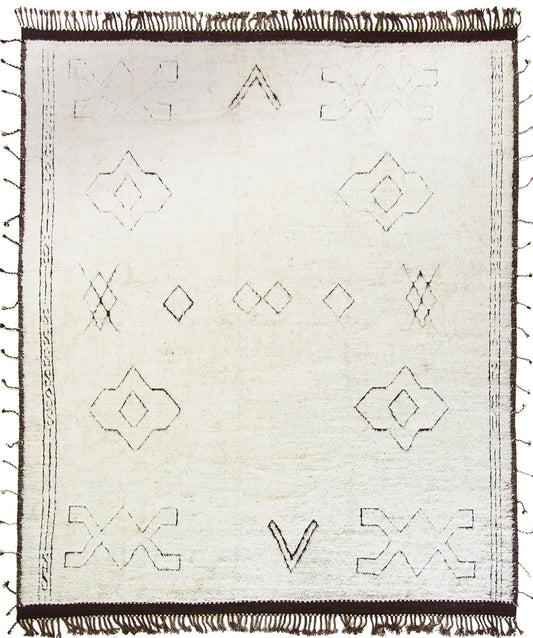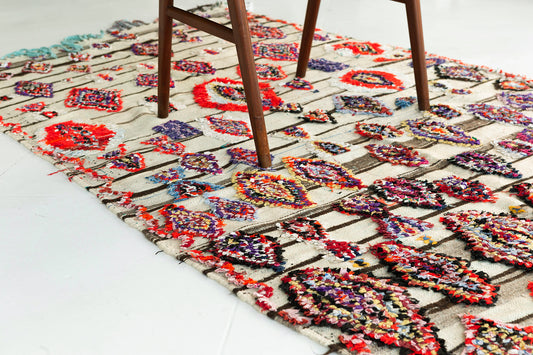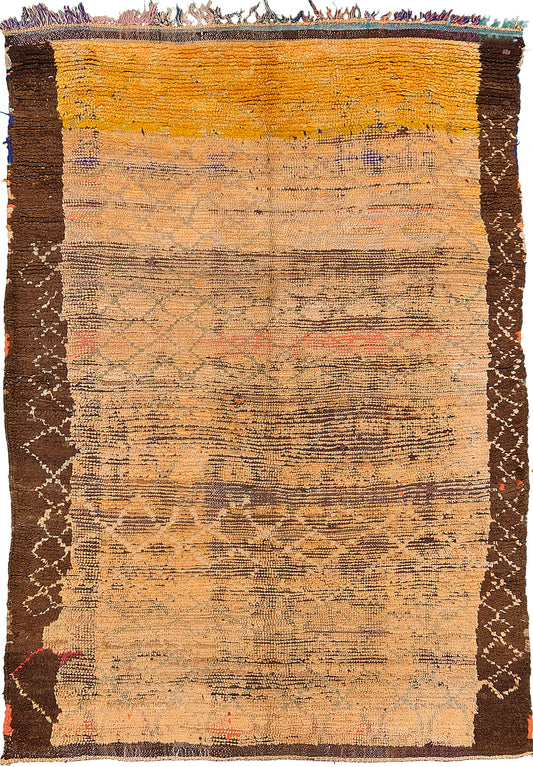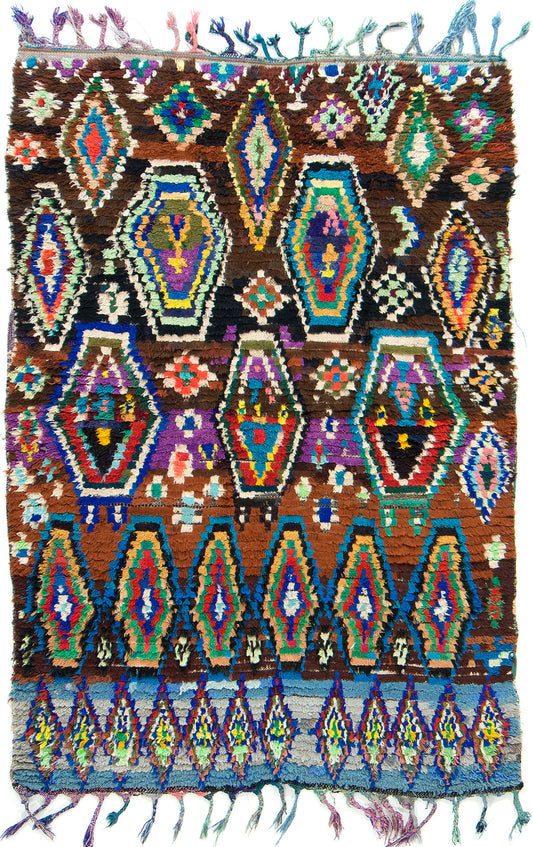-
Antique Moroccan High Atlas Tribe Rug
Regular price $5,800.00 USDRegular price Sale price $5,800.00 USDUnit price per -
Brubu, Haute Bohemian, Ivory Black
Regular price $14,850.00 USDRegular price Sale price $14,850.00 USDUnit price per -
Moroccan Kilim Tiflet Flat Weave
Regular price $6,650.00 USDRegular price Sale price $6,650.00 USDUnit price per -
Vintage High Atlas Rug
Regular price $9,500.00 USDRegular price Sale price $9,500.00 USDUnit price per -
Vintage Moroccan Azilal Tribe Berber Embossed Rug
Regular price $3,900.00 USDRegular price Sale price $3,900.00 USDUnit price per -
Vintage Moroccan Azilal Tribe Berber Rug
Regular price $4,900.00 USDRegular price Sale price $4,900.00 USDUnit price per -
Vintage Moroccan Azilal Tribe Berber Rug
Regular price $2,900.00 USDRegular price Sale price $2,900.00 USDUnit price per -
Vintage Moroccan Azilal Tribe Berber Rug
Regular price $4,800.00 USDRegular price Sale price $4,800.00 USDUnit price per -
Vintage Moroccan Azilal Tribe Berber Rug
Regular price $3,750.00 USDRegular price Sale price $3,750.00 USDUnit price per -
Vintage Moroccan Azilal Tribe Berber Rug
Regular price $8,500.00 USDRegular price Sale price $8,500.00 USDUnit price per -
Vintage Moroccan Azilal Tribe Berber Rug
Regular price $4,500.00 USDRegular price Sale price $4,500.00 USDUnit price per -
Vintage Moroccan Azilal Tribe Berber Rug
Regular price $4,300.00 USDRegular price Sale price $4,300.00 USDUnit price per -
Vintage Moroccan Azilal Tribe Berber Rug
Regular price $4,750.00 USDRegular price Sale price $4,750.00 USDUnit price per -
Vintage Moroccan Azilal Tribe Berber Rug
Regular price $2,770.00 USDRegular price Sale price $2,770.00 USDUnit price per -
Vintage Moroccan Azilal Tribe Berber Rug
Regular price $2,800.00 USDRegular price Sale price $2,800.00 USDUnit price per -
Vintage Moroccan Azilal Tribe Berber Rug
Regular price $3,960.00 USDRegular price Sale price $3,960.00 USDUnit price per -
Vintage Moroccan Azilal Tribe Berber Rug
Regular price $4,000.00 USDRegular price Sale price $4,000.00 USDUnit price per -
Vintage Moroccan Azilal Tribe Rug
Regular price $4,500.00 USDRegular price Sale price $4,500.00 USDUnit price per -
Vintage Moroccan Azilal Tribe Rug
Regular price $2,275.00 USDRegular price Sale price $2,275.00 USDUnit price per
Collapsible content
More About Handmade Moroccan Rugs: A selection of favorites
Handmade Moroccan Rugs: A Time-Honored Craft in the Modern World
Handmade Moroccan rugs are more than just home decor; they represent a rich cultural heritage passed down through generations. These rugs are crafted with intricate attention to detail, using methods that have remained largely unchanged for centuries. From sourcing fibers to finishing, the process of making a Moroccan rug by hand is an art form in itself. In this article, we will explore the various steps involved in creating a traditional handmade Moroccan rug, including fiber sourcing, spinning, carding, dyeing, and weaving. We'll also discuss how Moroccan artisans have adapted their traditions for contemporary markets and why these rugs are a unique addition to modern spaces.
Fibers Used and Their Sources
The materials used in handmade Moroccan rugs are sourced from local environments, ensuring that each rug carries the essence of the region it comes from. The primary fiber used is wool, which is sourced from sheep raised in the Atlas Mountains and surrounding regions. The wool is known for its durability, softness, and ability to retain warmth, making it an ideal material for high-quality rugs. In some regions, camel hair and goat hair are also used, though these fibers are less common.
In addition to animal fibers, recycled textiles have become an integral part of some Moroccan rug-making traditions, particularly in the creation of Boucherouite rugs. These rugs are woven using leftover fabrics, clothing, and even industrial textiles, showcasing the weavers’ ingenuity and resourcefulness.
The Rug-Making Process: Step by Step
1. Shearing and Sorting: The process begins with shearing the wool from sheep, which is then sorted based on quality. The best-quality wool is reserved for the finest rugs, while lower grades may be used for more utilitarian pieces.
2. Carding: Before the wool can be spun, it must be carded, which involves brushing the wool fibers to align them in the same direction. This step ensures a smooth and even texture when the wool is spun.
3. Spinning: Once carded, the wool is spun into yarn using a spindle. This labor-intensive process requires great skill, as the thickness of the yarn must be consistent to ensure the evenness of the final rug. In traditional settings, the spinning is done by hand, often by women within the family.
4. Dyeing: The spun wool is then dyed using natural pigments derived from local plants, minerals, and insects. Common natural dyes include indigo for blue, madder root for red, and saffron for yellow. These dyes are prized for their ability to retain vibrancy over time, giving the rugs their rich, earthy tones. For rugs made from recycled textiles, the fibers may come pre-dyed, resulting in more varied color schemes.
5. Weaving: The most crucial step in the process is weaving, which is traditionally done on vertical looms. These looms, often made of wood, are set up in homes or communal workshops. The weavers are usually women, who have learned the craft from their mothers and grandmothers. They work for hours at a time, meticulously interweaving the wool to create the desired patterns. Some looms are portable, allowing the weavers to move their work as needed, while others are fixed in one place.
6. Common Weaves and Motifs: Moroccan rugs are known for their variety of weaves, from flatweaves like Kilims to high-pile rugs such as Beni Ourain. Flatweaves are lightweight and often feature geometric designs, while high-pile rugs are thicker and softer, with simpler, more abstract motifs. Diamond patterns, zigzags, and symbolic motifs such as the evil eye, fertility symbols, and representations of nature are common across all types of rugs.
7. Finishing: Once the weaving is complete, the rug is cut from the loom and the edges are reinforced. Some rugs undergo a washing process to soften the wool and enhance the natural sheen of the fibers. Finally, the weavers trim any loose threads and ensure the rug is ready for use.
How Long Does It Take to Make a Handmade Moroccan Rug?
The time it takes to create a handmade Moroccan rug varies depending on the size, complexity of the design, and the skill of the weaver. A small rug may take several weeks, while larger or more intricate pieces can take several months to complete. The work is often done in stages, with weavers dedicating hours each day to their craft, balancing it with other household responsibilities.
Traditional Uses for Rugs in Morocco
In Moroccan culture, rugs serve multiple purposes beyond floor coverings. In Berber households, they are often used as bedding, seating, or blankets. Due to their insulating properties, handmade rugs are particularly valuable in the cold mountain regions, where they help retain warmth during harsh winters. Rugs also play an important role in ceremonial and social gatherings, such as weddings, where they are used to create a welcoming, comfortable space for guests.
Adapting Traditions for Contemporary Markets
Moroccan artisans have adapted their traditional rug-making techniques to meet the growing demand in contemporary markets. Today, many weavers create custom designs for international buyers, incorporating modern color schemes and motifs while maintaining the integrity of their ancestral methods. This shift has opened up new opportunities for Moroccan artisans, who can now reach a global audience.
In urban centers like Marrakech, artisans have established rug cooperatives, which allow them to pool resources and market their work more effectively. These cooperatives have also helped preserve the art of rug-making, ensuring that younger generations continue to learn the craft.
Regions in Morocco with Handmade Rug Traditions
Morocco’s diverse geography gives rise to a wide range of rug-making traditions. Some of the most prominent regions include:
-
The Atlas Mountains: Home to the Beni Ourain tribe, this region is known for its thick, high-pile rugs made from natural, undyed wool. These rugs are minimalist, featuring simple geometric patterns.
-
The Middle Atlas: The Azilal region produces colorful, high-pile rugs that often incorporate both wool and cotton. These rugs are known for their abstract, vibrant designs.
-
The Sahara Desert: The desert tribes of southern Morocco, such as the Tuareg, craft flatweave rugs using recycled textiles, known as Boucherouite rugs. These pieces are highly durable and often feature bold, geometric designs.
-
Rabat: Rugs from this urban area are more refined, often featuring complex floral and arabesque motifs influenced by Islamic art.
Uniqueness of Handmade Moroccan Rugs
What sets handmade Moroccan rugs apart is the personal touch of the weavers. Each rug tells a story, reflecting the weaver’s life experiences, regional influences, and even spiritual beliefs. No two rugs are exactly alike, as the patterns, motifs, and colors vary depending on the materials available and the weaver’s individual style. The use of natural fibers, hand-spinning techniques, and traditional dyes adds a level of authenticity and uniqueness that machine-made rugs simply cannot replicate.
How Handmade Moroccan Rugs Work in Modern Spaces
Handmade Moroccan rugs have become a popular choice in modern interiors due to their versatility and timeless appeal. Their bold patterns and rich textures add warmth and character to minimalist spaces, while their earthy tones and organic materials complement contemporary designs. Whether used as a statement piece in a living room, layered over other rugs, or hung as wall art, Moroccan rugs can easily enhance the aesthetic of any room.
In open-concept spaces, large Beni Ourain rugs create a sense of coziness and define areas without overwhelming the room. In more eclectic interiors, Boucherouite rugs add a splash of color and whimsy, reflecting the creative spirit of the artisans who made them.
Conclusion
Handmade Moroccan rugs are a testament to the enduring legacy of Moroccan artisanship. Each rug is a work of art, crafted with care and skill, and designed to last for generations. As these rugs continue to gain popularity in contemporary markets, they bring a piece of Morocco’s rich cultural heritage into homes around the world, offering a unique blend of tradition, craftsmanship, and beauty.











































